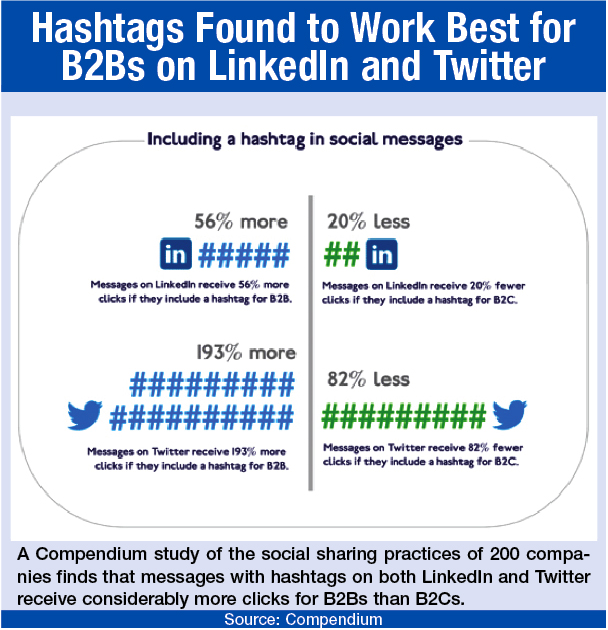 |
A study covering B2B and B2C companies and their social sharing practices released in October 2012 by Compendium finds that there are some significant differences between what works for the two sectors.
For example, tweets of 11-15 words in length worked best for B2B companies, while tweets of 1-5 words are preferred for B2Cs.
When it comes to social messaging, PR News was most interested in the use of hashtags within B2B and B2C. The collected data for each seemed far different, so we asked a couple of social media experts to give some insights into the data, and to provide some tips as to how hashtags can be best utilized (for the hashtag findings, refer to the graphic).
B2B AND RELATIONSHIPS
Why such a difference between B2B and B2C? Frank Strong, director of PR at Vocus, says there’s a couple of dynamics at play. “First, the study reinforces my perception that B2B marketers are especially focused on relationship building on social networks, while B2C marketers are generally more interested in a broad reach,” says Strong.
And second, hashtags are excellent at bringing people together who share an interest and are inherently inclined to re-share content they find compelling, says Strong.
Brad McCormick, principal at 10 Louder Strategies in Austin, Texas, agrees with Strong that there is more B2B business value to be had in social media than there is for B2C. “The reason is simple. B2B audiences go online to talk business. B2C audiences don’t,” says McCormick. “They go on alone to talk about lifestyle, friends, etc. So its often easier for a B2B company to tap into existing relevant conversations than B2C audiences.”
THE LIKEMINDED
Vocus uses hashtags to connect with likeminded people, says Strong. “If SEO allows content marketers to connect with people who share an interest in a given topic through search, then hashtags perform a similar function on social,” he says. Strong characterizes Vocus’ tactical use of hashtags here:
1. Listening. Vocus monitors popular hashtags related to its business to keep abreast of hot topics, content and trends.
2. Curating. The company publishes a variety of content that appeals to different functions within marketing—for example, social media, SEO, e-mail marketing and PR—and experiments with the most popular hashtags in each function.
3. Attracting. Hashtags have proven to be an important part of Vocus events. “We’ve had as many as 10,000 registrants for our webinars, and when we have that many people sharing content from the webinar under the same hashtag, it grows like compound interest,” says Strong.
McCormick’s hashtag tips include:
• It’s easier to use an existing hashtags then to create new ones, so do your research. Find how which ones are already been used by your audience and go with those.
• Retweet and tag conversations that do not have the appropriate hashtag. “If you see a tweet that is related to #BigData but hasn’t been tagged yet, you are doing a service to the original author and the #BigData community at large by tweeting that tweet with the appropriate hashtag,” says McCormick. PRN
CONTACT:
Frank Strong, [email protected]; Brad McCormick, [email protected].
